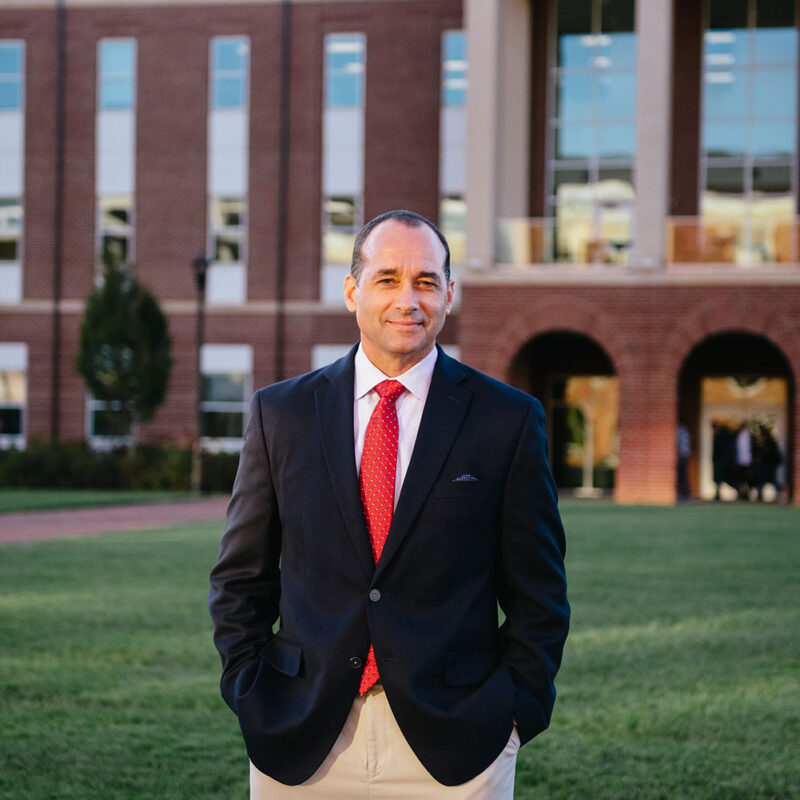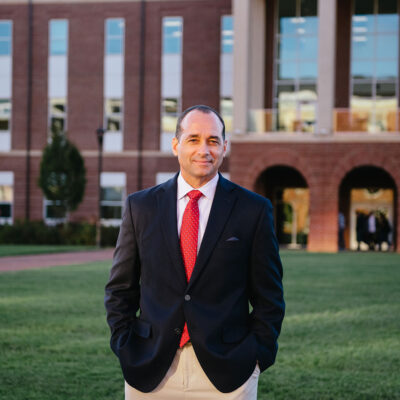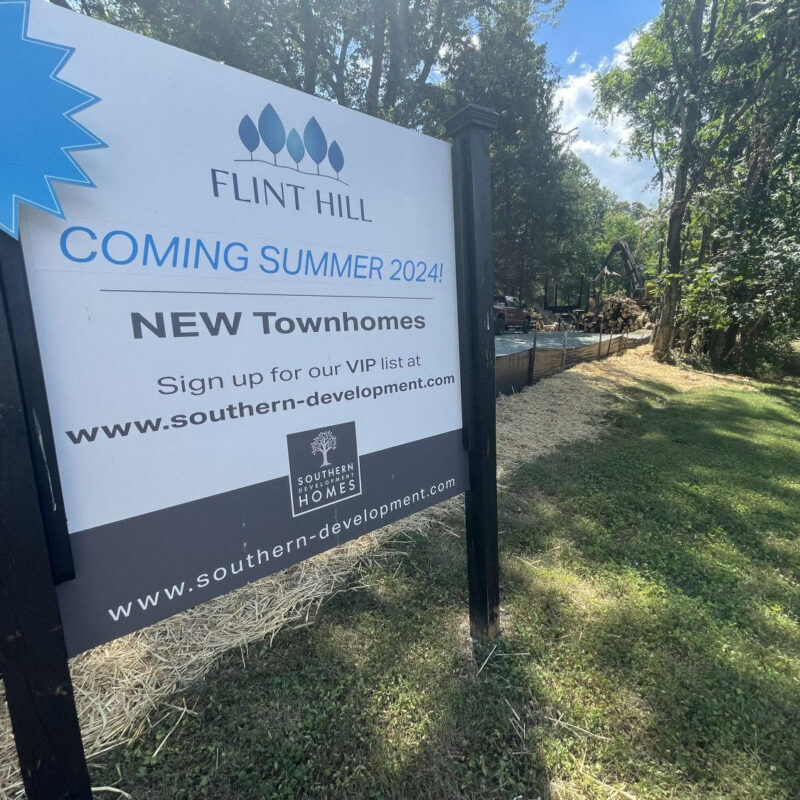The Landmark Hotel—intended to become a 10-story boutique luxury hotel with 101 rooms, a five-star restaurant, and a roof top bar—started as a $30 million project that even the Board of Architectural Review could love. Now, only Mother Nature is working on the skeletal tower that stands as a sardonic reminder of the times.
That doesn’t mean that the men who planned and financed the thing aren’t hard at work. It’s just that they’re paying lawyers rather than contractors, and the case file is already a landmark in its own right, 8” of filings in three bloated folders in the bowels of the Charlottesville Circuit Court.
|
Doomed love: Almost as soon as Halsey Minor carried Lee Danielson over the threeshold, their relationship began to crumble. |
Currently, the case is predominated by a back and forth between Halsey Minor, who has about $7 million staked on the project, and Specialty Finance Group, which loaned Minor $23.7 million to build the hotel. Minor is accusing the bank of colluding with his agent, Lee Danielson, in order to bilk him of his investment. The bank says Minor has broken his part of the bargain and should pay back $10.5 million of the loan so it can get someone else to finance the project.
What’s the real story? Who knows—maybe a judge can sort that out. But those reams of bitter filings offer the chance to get the kind of details that usually remain hidden in private contracts. The following timeline of the story to date is based on court records and press accounts.
Courtship
During which Lee Danielson conceives of the hotel project; struggles to build without a wealthy partner; and finally meets the man of his dreams.
1998: Halsey Minor meets Lee Danielson for the first time.
2000: Danielson and his business partner Colin Rolph purchase former Central Fidelity bank (known to many as the former Boxer Learning Center) at the corner of Main Street and Second Street SE from Wachovia for $1.8 million.
2002: Danielson and Rolph’s partnership dissolves. The properties are divvied up in court. Danielson buys Central Fidelity parcels for $3.3 million.
2004: Danielson conceives of the boutique hotel project, and has San Francisco architecture firm Hornberger + Worstell draw up renderings for a 100-room, nine-story building. For once, the Board of Architectural Review loves his idea and gives unanimous approval.
Cast of Major Characters
|
December 2004: Hornberger + Worstell put mechanic’s lien on the site for $176,000.
June 2006: Danielson settles the mechanic’s lien and sells the property to Charlottesville/Lynchburg developer Oliver Kuttner for $3.7 million.
October 2006: Despite selling the property, Danielson is still interested in the hotel idea, and works with a man named Michael Palmer to finance the project.
Minor and Danielson talk about the hotel idea for the first time at the Bel-Air Country Club in Los Angeles, California. Danielson serves as Minor’s sponsor to get him membership, according to Danielson.
February 2007: Danielson announces that he will repurchase the hotel site from Kuttner, and gets the BAR to sign off on his plan again.
“He spent a lot of money and time designing it,” Kuttner tells C-VILLE. “If it wasn’t being built, then it would be a waste, and I didn’t want to see it be a waste.”
Spring 2007: A mortgage industry contact puts Danielson in touch with Specialty Finance Group, which specializes in hotel real estate projects.
June 2007: While Minor is in Charlottesville, he makes a “friendly inquiry” to Danielson about the project by e-mail. Danielson replies that he’s still working with someone else, but exhorts Minor to eat at the Downtown Grill and wishes him well on his tennis game.
July 2007: Danielson and Palmer decide they won’t do the project together. Danielson sends Minor an e-mail with a bank appraisal: “It would be terrific to make this project work. I understand where you are coming from in terms of quality and certainty of the end product. There should be a way to work our way through this so that it is what we both would want.”
Matrimony
During which Halsey Minor and Lee Danielson are joined together by holy contract; borrow money to birth their Landmark Hotel; and fall out of love.
August 2007: Minor buys hotel site from Oliver Kuttner for $4.5 million. Project is dubbed “The Landmark Hotel.”
November 2007: Minor and Danielson enter into development agreement, whereby Danielson will represent Minor as his agent on the project. Danielson gets paid $30,000 per month, as well as a share of the profit of the project. Minor agrees to pay back Danielson $312,000 for earlier work on plans and entitlements.
February 2008: Workers begin walling off former Central Fidelity/Boxer building for demolition.
March 11, 2008: Minor and Danielson hold official groundbreaking with Mayor Dave Norris. Minor says of the Landmark, “It’s going to be like nothing people have ever seen.” Group retires to Downtown Grill for celebratory luncheon.
March 12, 2008: Minor signs construction loan with Specialty Finance Group for $23.69 million to be repaid by April 1, 2013. Minor also contributes $1.8 million more to the project, which has a total cost of $30 million. Construction completion date is slated for March 7, 2009.
April 2008: Minor makes request on the loan. SFG informs Minor that the loan is already out of balance, and Minor agrees to put in $400,000 more, bringing his commitment to about $7 million. The construction cost is adjusted down from $22 million to $19.6 million, and the completion date pushed back to August 30, 2009.
September 2008: Danielson calls SFG to inform the lender that the hotel project is over budget by about $3 million, according to SFG.
October 2008: In the October edition of Portfolio magazine, Minor says that he insisted on being the sole investor in the Landmark Hotel project: “I don’t like squabbling.”
Later that month, Danielson tells Minor that there are over $3.3 million in additional costs to the project, according to Minor.
October 16, 2008: Landmark Hotel Construction Blog updated for the last time.
Acrimony
During which Minor and Danielson stop communicating; malign each other in the press; get separation.
November 3, 2008: Contractor submits change order request of $5.2 million, according to Minor. He claims that SFG “continued to insist that construction proceed …despite Owner’s wishes to slow down construction” while he reviewed the costs.
November 10, 2008: Word leaks from Landmark construction workers that project is coming to a halt because they aren’t being paid.
November 11, 2008: Daily Progress runs a story quoting Minor that the project is coming to a halt because of issues with SFG’s parent company, Silverton.
That morning, SFG tells Minor that it won’t fund the project until Minor can make assurances about the budget and tries to meet with Minor. Minor’s assistant replies in an e-mail, “We have now retained counsel.”
November 12, 2008: Construction management firm Clancy & Theys puts $3.1 million in mechanic’s liens on the property. Minor tells C-VILLE that Silverton Bank “basically defaulted on their loan.”
November 13, 2008: SFG sends a default notice letter to Minor, citing change orders of $3.5 million to $4 million, and Minor’s recalcitrance in not responding. It insists that Minor put more money into the project in order to get his equity at the proper level.
Meanwhile, Danielson tells C-VILLE, “Everybody’s working, everybody’s paid, everybody’s fine. I don’t understand what’s going on. It’s been a pleasure to work with the bank.”
That evening, Minor sends e-mail to C-VILLE saying, “I am the 100 percent owner. The project has been closed due to a bank default. [Lee Danielson] is the former developer. We won’t be needing his services when the project resumes.” It’s the last time that Minor responds to a Charlottesville reporter.
November 14, 2008: Cliff Harrison, Danielson’s construction agent, tells C-VILLE there was a delay in payment, “but everything is on track. Everybody is on board to keep the thing moving forward. So far so good.” Work continues on the site.
November 15, 2008: Silverton Bank issues statement: “Construction continues at the project site and funding of the loan is proceeding per the terms specified clearly in the loan agreement between the borrower and Specialty Finance Group. Any assertion otherwise is inaccurate.”
November 17, 2008: Minor sends Danielson a letter that their agreement is terminated effective November 28.
November 20, 2008: Clancy & Theys’ mechanic’s liens are satisfied.
Divorce
During which Minor sues Danielson and lender Specialty Finance Group; and SFG sues Minor back.
December 4, 2008: SFG and Minor finally meet face-to-face in SFG’s Atlanta office. According to the bank, Minor says that contracts can be renegotiated for lower amounts because of the economic downturn and says he will submit a revised budget by January 8.
According to Minor, he tells SFG that he wants to stop construction, but SFG “insisted that the appearance of construction continue despite the financial harm that it was causing to the Project.” Minor hires outside consultants to review the plans.
December 9, 2008: Minor says that he sends Danielson a cease and desist letter, telling him to quit talking about the project to other parties.
December 18, 2008: Minor sends SFG a list of “goals and tasks,” but never sends a revised budget, according to SFG.
January 13, 2009: An anonymous construction worker tells C-VILLE that work on the hotel will be stalled for at least 60 days, citing engineering and design issues. Later in the day, local attorney Steve Blaine says that he is the new voice for the project, and assures C-VILLE that work will continue. It is the last time Blaine returns calls about the project.
January 29, 2009: Danielson sends e-mail to various subcontractors on the project to arrange a conference call to discuss how to get money from Minor.
Danielson writes, “Certainly [Minor] represents that he has money in that he is living life as usual and making bids to buy racetracks and start a casino in Maryland. He lives in a home in LA that he rents for more per month than many of us are owed for the whole project. Clearly The Landmark and the hard working professionals associated with it are not a priority.” [Danielson’s bolding]
Early February, 2009: SFG gets a subpoena from attorneys for Merrill Lynch regarding a $25 million lawsuit against Minor.
February 11, 2009: Minor files suit against Danielson and SFG, claiming breach of fiduciary duty, fraud in the inducement, fraud, and constructive fraud as well as two counts of breach of contract against Danielson.
Minor’s main contention: “Lender colluded with Agent [Danielson] and actively concealed the fact that the construction budget was not realistic until after the construction loan closed and Halsey Minor was personally on the hook for the cost to compete the project.”
February 19, 2009: Minor and SFG hold a conference call. According to SFG, Minor admits “what SFG feared to be the case: that he and MFH had mismanaged the project and that it was significantly out of budget, to the tune of $20 million.” A $30 million project was now at least a $50 million one. SFG also claims that the conversation takes “a surreal turn” as Minor goes on an “obscenity-laced tirade” blaming the bank.
In Minor’s version of events, SFG uses the consultant’s explanation “as a pretext to call the loan in default. …Lender hung up on us when I asked a question regarding the Loan’s initial budget.”
February 20, 2009: Minor files amended complaint in his lawsuit, expanding his charges against SFG to include breach of implied covenant of good faith and fair dealing and breach of contract over the loan agreement.
February 23, 2009: SFG accelerates the loan, requesting Minor immediately pay back $10.5 million.
February 24, 2009: SFG files suit against Minor in Georgia, seeking a judgment against Minor for the $10.5 million, as well as for attorney’s fees. Among its reasons are Minor’s refusal to submit a revised budget and that he has had a “material change” in his financial status, citing the $25 million Merrill Lynch lawsuit.
February 26, 2009: Silverton Bank is ordered by the Office of the Comptroller of the Currency to increase its capital and restructure the organization because of bad loans.
March 3, 2009: Even though SFG hasn’t begun foreclosure, Minor files application for temporary restraining order and preliminary injunction in order to keep SFG from foreclosing.
“The Project was to be my legacy in my hometown of Charlottesville,” said Minor in the court filings. “In my opinion, if the property I purchased for the Project is foreclosed on, the hotel will never be built.”
March 4, 2009: City works with construction contractor Clancy & Theys to remove some of the scaffolding on Second Street. Patrons of The Box finally get breathing room.
March 11, 2009: SFG responds to Minor’s application for temporary restraining order and preliminary injunction. The filings characterize Minor’s moves thusly: “In a desperate attempt to avoid their obligations under the loan documents, Plaintiffs attempt to manufacture a claim that they were ‘duped’ into applying for and obtaining the loan, and therefore they should be relieved of their obligation to repay it.
“The public interest is better served by allowing SFG to foreclose. The most expeditious manner in which to complete the hotel is to allow SFG to take control of the property and sell it to another developer who has the wherewithal to complete the hotel.”
March 12, 2009: Charlottesville Circuit Court Judge Edward Hogshire denies Minor’s injunction to stave off foreclosure, but does force SFG, which had tried to get out of the case, to respond to the complaint.
C-VILLE welcomes news tips from readers. Send them to news@c-ville.com.






